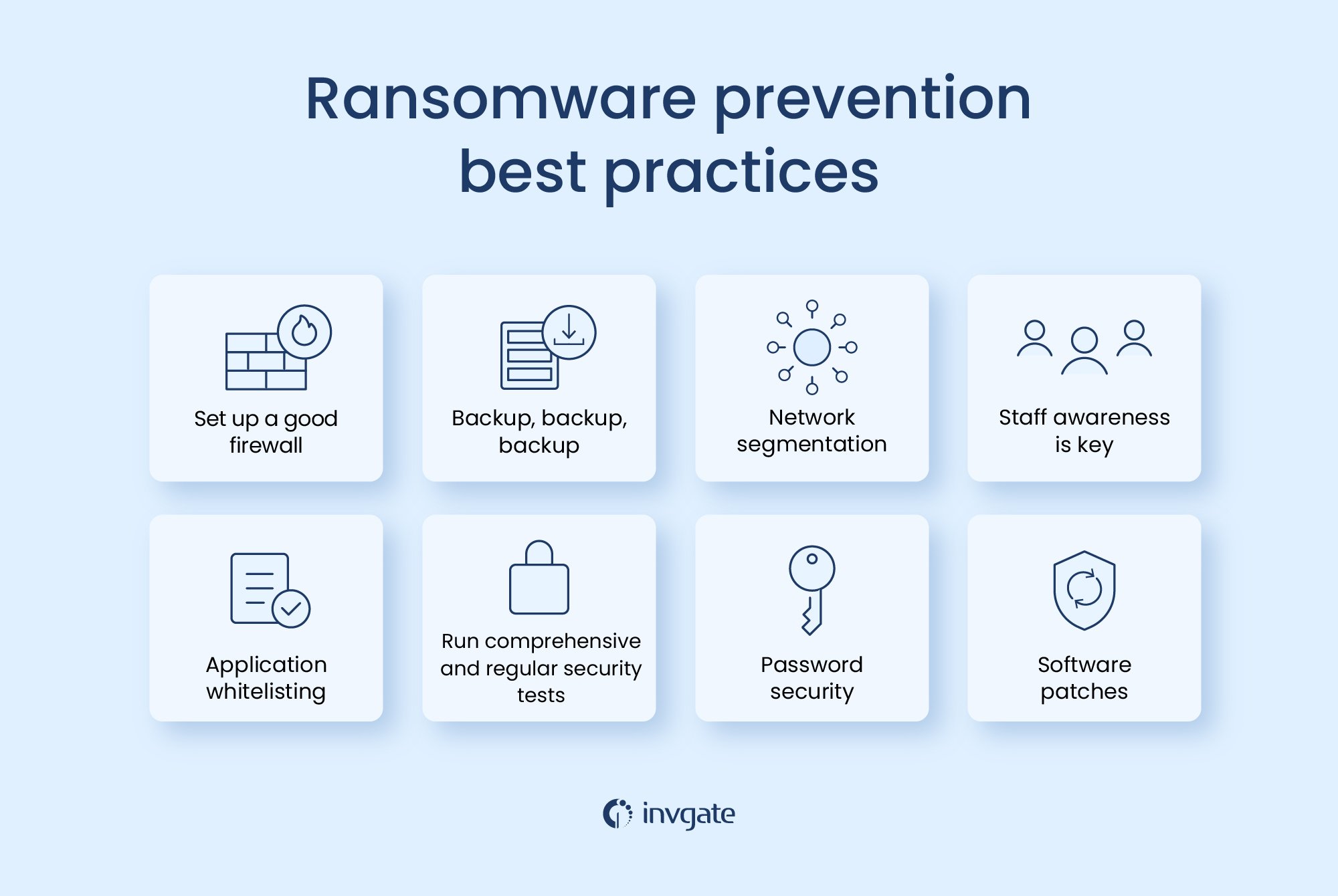Cybersecurity is more important now than ever before. With ransomware and other types of cyberattacks on the rise, it’s crucial to take precautions to protect your data by learning how to prevent ransomware.
Ransomware, unfortunately, is one of the ubiquitous scourges on the internet. You’ll have to take every possible measure to protect against it. If you leave things up to chance, you’ll incur severe financial losses or compromise mission-critical information and resources.
Today, it's more critical than ever to have a comprehensive vulnerability management program in place. By understanding the anatomy of a ransomware infection, you can be better equipped to protect your organization from this growing threat.
Needless to say, if you do fall victim to ransomware, don’t panic. There are steps you can take to try to recover your files. Fortunately, we’ve created this complete ransomware prevention guide to help you keep your data safe. And, if you’re still a little lost about what it entails, don’t worry. We’ve got a simple definition to get things started.
What is ransomware?
Ransomware is malicious software (or malware) that holds your information hostage. The malware owner can either threaten to publish your information or deny you access to it until such a time as a ransom of their choosing is paid, hence the name. Of course, this is typically a pretty penny.
The ransom can either be paid in fiat currency or untraceable cryptocurrency. In this case, it’s bye-bye forever and a toss-up on whether you will even be allowed to re-access your data. In the worst-case scenario, you would be staring at a lose/lose proposition.
And, to give you an even more stark reminder of the kind of damage a ransomware attack can do, take a look at these insights from the 2021 Verizon Data Breach Investigations Report:
- Ransomware is the second-most-popular type of data breach, right below C2 (Command and Control) breaches.
- The total delivery for this type of malware? None other than good old malicious emails or spam.
- In 2019, the city of Baltimore was the victim of a ransomware attack. The total recovery cost was $18 million.
- Ransomware attacks have a total cost of over $11 billion per year to fix.
- No one is safe: government facilities are a favorite cyberattack target.
Therefore, your best bet is to learn how to prevent ransomware by ramping up every possible security measure. The alternative is not something you even want to consider.
How does ransomware work? The anatomy of a ransomware attack
Learning how to prevent ransomware is all about knowing the process. And this is because this malware doesn’t automatically infect your system; it follows a multi-stage path before you’re well and truly locked out. Knowing, as they say, is half the battle, so here’s the anatomy of a ransomware infection.
1. Infection
More often than not, the best way to “deliver” ransomware is by instigating a phishing attack or scam. Typically, you’ll see ransomware cleverly disguised as an attachment or executable file. The attack will only be localized to your computer if you're lucky. If you’re not, though, it might cascade through the whole network.
2. Exchange of security keys
The malware's second thing is stealthily connecting to the cybercriminal — the attacker/s behind the program — to inform them about a successful breach. Once done, it will receive the cryptographic keys necessary to encrypt your data.
3. The encryption process
Now is the time for the ransomware to work its dark magic and start encrypting your files. If you’re lucky, it might begin to slow locally and work its way up your network. Some malware will make restoring backups harder, hone in on your crypto wallet, or try to replicate itself, so it reaches other devices on your network before you even know what hit you.
4. The ransom
If you haven’t been able to stop this security threat during one of the previous stages, this is where the attacker will try to extort you. If the ransomware attack gets this far, you’re dead in the water and have to comply with their demands.
The first step is that you’ll receive some extortion note with a dollar figure attached and a link to a bank account or — most likely — a crypto wallet. While crypto has many upsides, its intractability can be either a boon or a bane depending on what side of the street you’re on; in this case, you’re most likely not going to be singing its praises if you’re getting forcibly separated from your hard-earned cash.
If you don’t comply, the threat will probably escalate. Some attackers will deny you access to your files forever; others will threaten to expose vital or sensitive business information to the public. This is because some ransomware variants can exfiltrate data to the attackers, which makes matters worse. Sadly, this is where not being able to prevent ransomware attacks gets you.
You’ll get to the next and final step if you're lucky.
5. The recovery
All paid up? The attackers will deliver the encryption key and give you access to your data back.
But suffice it to say that this happy ending isn’t the most likely scenario and doesn’t happen often. Remember the case mentioned above in the city of Baltimore? They had to recover their data manually and, of course, couldn’t bring all of it back from under the encryption. The process was time-wasting, costly, and frustrating.
Knowing how to prevent ransomware attacks is the only possible way to ensure the safety and security of your information. It’s the only common-sense route and the only one that provides real peace of mind.
And what's the best way to prevent an attack? Know what you’re up against.
If you follow our tips, you can help reduce your risk of ransomware attacks. But, no matter how careful you are, there’s always a chance that you could be targeted. So, it’s also important to have a plan for what you would do if you were hit with ransomware.
4 common types of ransomware to prepare for
Hackers and cybercriminals are developing new types of ransomware practically every minute. These use different “transmission vectors” like p2p programs and platforms, but mostly rely on malvertising, like phishing emails and other well-known scams.
Moreover, even “boutique” malware just compounds the problem. People who beef with someone can go to ransomware-as-service sites, chat channels, or other shady corners of the internet and either commission ransomware, or buy what hackers sell. It’s no wonder that the incidence of cyberattacks is increasing!
In our quest to learn how to prevent ransomware, we must take a look at this list of four common types of ransomware to be alert.
1. Crypto ransomware
This is the first and most common ransomware, so it earns the first spot on this list. Of this type, the most infamous right now are CryptoWall and CryptoLocker, primarily due to having powerful encryption.
In simple terms, encryption is a way to encode data so that it’s inaccessible without the corresponding key. There are two types of keys: symmetric and public.
- Symmetric keys happens when the attacker uses the same keys for encryption and decryption. Of course, this type of key is only effective when both ends of the chain can keep the key secret. Some common types of keys are Advanced Encryption Standard (AES), Rivest Cipher 4 (RC4), and Data Standard Encryption Standard (DES).
- Public keys: Public or asymmetrical keys are freely accessible by everyone, and private keys are controlled by the owner and the person whom they intend to communicate with. One famous example is the RSA algorithm.
2. Locker ransomware
Ransomware like Winlock has made this a prevalent type of attack. It entails creating a fake login screen or HTML site that’s hard to remove from your screen. Never give in if a random screen asks for your money.
3. Mobile ransomware
Mobile platforms have proprietary security systems and are vulnerable to a well-staged ransomware attack. Mostly, these fall under locker type ransomware, as mobile phones tend to have very reliable backup systems.
4. Ransomware as a service (RaaS)
Remember we mentioned that people can commission ransomware or buy what hackers sell? Well, RaaS consists of cyber attackers renting access to a ransomware strain from its author. In an attempt to create a business model out of a ransomware attack, attackers create some sort of affiliate network where the most experienced ones sell their malware as a pay-for-use service.
Ransomware prevention best practices
By this point, it’s obvious how much of a security risk ransomware presents. And since — theoretically — an encryption can be broken, brute-force cracking (or attempting every possible combination for a key) is time-consuming, expensive, and doesn’t always work.
With this in mind, ransomware prevention is still going to be your best bet.
The most basic step here is good data backup practices, of course. If you have an updated backup, the sense of urgency to recover information — and one of the attackers' most valuable asset — is gone.
To further extend this, here’s a list of common-sense best practices to avoid standard systems. Avoid weaknesses and suspicious ads to minimize the threat ransomware poses to the integrity of your information.

1. Set up a good firewall
At this point, this is cybersecurity 101, but you’d be surprised at how many companies drop the ball this early in the game. Let’s be clear: setting up a good firewall will be your first line of defense against an attack. First, it scans any incoming or outbound traffic in your network. Second, it lets your IT team have a clear picture of what’s going on and nip any possible malware in the bud.
Remember, when it comes to firewalls, be mindful of:
- Threat hunting. Have a firewall with DPI (Deep Packet Inspection) capabilities to thoroughly analyze information.
- Tagging workloads actively.
- Evaluate whether your information traffic contains mission-critical apps, services, or data.
2. Backup, backup, backup
You should be backing your information up at regular intervals. Even more so, you should create immutable backups, a data backup practice that makes stores that can’t be altered or deleted by anyone.
Having immutable backups can mean the difference between paying a hefty ransom and saying, “Eh, I’ve got all my information backed up, thanks. Delete to your heart’s content.” You don’t have to worry about your business being put out of commission by an attack or your data being encrypted, even if a cyber criminal reaches your backup.
As an extra line of defense, you should back up your information at least twice daily, with redundant backups online and offline. If you’re attacked, it’s back to the most recent clean backup.
But, of course, this isn’t a cure-all either, as you still run the risk of your information — or your clients’ — being exposed. So, it’s on the following measures.
3. Network segmentation
When a ransomware threat enters your system, you need to act fast because it’ll most likely start replicating itself, attempting to reach other areas of your network laterally. This is where network segmentation comes in by creating subsystems and preventing intruders from moving freely across devices.
If you have strict security controls, a separate firewall and gateway for each system, and individual access policies, you’re well on your way to a properly segmented network.
The endgame here is that if an attacker compromises one part of your network, the others will still be able to operate independently and untouched by the threat, giving you more time to respond accordingly. And, as a silver lining, less of your information is compromised.
4. Staff awareness is key
We can’t understate how important it is for your staff to know about ransomware prevention. And yes, regardless of our best intentions, we can never entirely remove the possibility of human error. Still, regular cybersecurity and threat awareness training are necessary for survival in the digital ecosystem.
Here are some things your staff, from junior to senior, should know about:
- How to recognize what a typical phishing attack looks like.
- Keeping their systems updated and following security protocols.
- Recognize suspicious files, links, and websites.
- How to keep their credentials safe.
- Choosing strong passwords and good “password hygiene.”
- Know how to recognize suspicious and probably malicious software, and learn how to install legitimate ones properly.
Will these things keep you and your staff 100% safe? No, but you’d be surprised at how much migraine medication you can save up on.
5. Application whitelisting
In layman’s terms, this means allowing applications to be operated on your system. A “white” list is for authorized software, and a "blacklist" is for blocked ones. This practice applies to both software and websites, and whitelisting, in general, is much safer and less restrictive for employees; they know they can safely use what’s on their computer, and that’s that.
6. Run comprehensive and regular security tests
Checking your system for potential vulnerabilities and threats is becoming increasingly important. For example, scanning your IT assets for potential threats is pretty much an everyday thing for IT teams. Other exploits to look for:
- Weak passwords or lousy password hygiene.
- Staff behavior that could compromise security.
- Flaws that could allow for the installation of backdoor programs.
- Bad authentication mechanisms.
- Old firewalls, OSs, or unpatched apps.
- System misconfigurations.
- Database errors in general.
If you’ve got a good IT team on your hands, they should be conducting regular read teaming or penetration testing. This mimics what an actual attack would look like and helps the teams spot weaknesses that would otherwise be too small or out-of-the-box to detect.
7. Password security
Strong passwords are one of the things that many companies mistakenly gloss over. We can’t tell you how often “Fido123” has led to an extremely sensitive system breach. So, don’t let this be you or your team; be mindful of maintaining solid passwords, repeated passwords that multiple people use, and, even more importantly, regularly refreshing passwords.
Is this behavior annoyance-free? No, we know that, but you can ease some of its nuisances by using password managers.
Ransomware prevention is about plugging every hole, big or small, and lax password standards are one of the first situations where things can go south. Unsurprisingly, hackers are especially fond of exploiting this type of low-hanging fruit.
8. Software patches
Keep your system up-to-date at all times. Ransomware is constantly evolving, and software companies are always implementing minute-by-minute fixes to protect you and your plan. Having a patch management strategy in place will help you have every device and app on your network running the latest stable patch available.
9. Other fixes
Of course, other fixes are just as important, and you should take them under advisement:
- Set up your browsers with ad blocker for Chrome.
- Familiarize yourself with email security best practices.
- Never give your employees more access than is necessary. Do not allow primary users to run any script on your network.
- Protect your wireless devices, as they can be ransomware entry points (laptops, cellphones, etc.).
- Display file extensions at all times.
- Restrict BYOD (Bring Your Device) unless necessary.
- Employ a CASB (Cloud Access Security Broker), a cloud-based intermediary between users and data, as an additional security measure.
- If a ransomware threat pops up, you should have the ability to immediately disconnect any devices on your network until the threat is contained.
These, and other all-important fixes, can make all the difference for you and your company. Always be mindful of potential security breaches and stay up-to-date on the latest and greatest ransomware prevention measures.
Key takeaways
In our digital age, there are various threats that can harm your computer or steal your data. But ransomware is one of the worst. It encrypts all of your files and demands a ransom payment in order to unlock them. If you don’t pay, you may never see your data again.
That’s why it’s so important to take steps to prevent ransomware attacks. Here are some tips:
- Make sure your software is up-to-date and has the latest security patches.
- Install a good antivirus program and keep it up to date.
- Use strong passwords and change them regularly.
- Be careful about what websites you visit and what attachments you open.
- Back up your data regularly.
By following these tips, you can help reduce your risk of ransomware attacks. But no matter how careful you are, there’s always a chance that you could be targeted. So, it’s also essential to have a plan for what you would do if you were hit with ransomware.
If you think you’ve been infected, disconnect your computer from the internet and contact your IT department or antivirus company immediately. They may be able to help decrypt your files without paying the ransom. And, remember, always have a backup of your data, so you can restore it if necessary.
Most importantly, preventing ransomware is all about being aware of the process. This means knowing the anatomy of a ransomware infection and understanding how to protect your system against it. As we’ve seen, ransomware doesn’t automatically infect your computer – it follows a multi-stage path before you’re well and truly locked out. So being aware of the different stages and taking appropriate steps to protect your system can go a long way in preventing ransomware from taking hold.
By understanding the process and taking appropriate steps to protect your system, you can help reduce your risk of becoming a victim.















